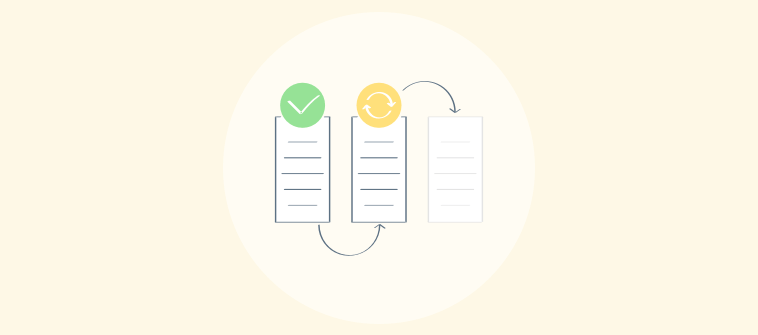Investing hours on a lead only to get turned down later can be pretty disappointing.
Not every lead you manage to pull in is there to make the purchase.
Wouldn’t it be perfect if you could identify the intention of your leads right off the bat?
This can help you avoid wasting time chasing after prospects that are not going to convert.
This brings us to the significance of qualifying prospects.
Identifying valuable prospects is critical to conserving time and resources. An efficient way of accomplishing using lead scoring best practices.
Lead scoring, as is evident from the name, involves scoring the leads before sales representatives pursue them. This improves the quality of leads and helps you utilize resources more effectively.
But what is the best way to score leads?
Several lead scoring models with varying scoring attributes exist. You can also establish custom criteria including relevant characteristics to score your leads.
This blog lists the best practices to help you get the most out of the exercise. These practices, coupled with an effective tool, can improve lead quality and produce better sales outcomes.
What is Lead Scoring?
While most businesses only worry about getting more leads, they fail to pay attention to a crucial aspect- lead scoring.
Consequently, they waste their time and resources on leads that will never make the purchase.
To make more sales, you need to ensure that the leads that you are working with are really interested in your business.
This requires the implementation of lead management best practices. One of these is scoring the leads effectively.
A clear picture of who’s only looking around and who has the real intention of buying can help you allocate time and resources more judiciously.
This is what lead scoring helps determine.
Let’s take a look at the lead scoring definition to understand what it means.
Lead scoring is a process that involves collecting relevant data about prospects and using it to assign a score.
The leads are scored based on a pre-defined set of criteria.
Simply put, it is a measure of how likely the lead is to make the purchase decision.
The attributes you choose to score your leads can vary depending on your business needs and buyer personas. These can include:
- Prospect demographics
- Email engagement
- Company details
- Website visits
- Social media activity
With access to relevant information about prospects, you can score and prioritize them.
Lead scoring is a process that can contribute to enhanced business efficiency. It can help you identify which marketing channels bring in the best quality leads and dedicate more resources to said channels. Additionally, it can bring more alignment between sales and marketing teams.
When sales representatives can easily prioritize prospects, they can focus more on selling to high-value customers and generate more revenue. Therefore, it is essential to understand what is a lead score and how to score leads.
How Can You Benefit From Scoring Leads?
Before getting into the nitty-gritty of lead scoring, let’s understand why it carries such significance.
Lead scoring provides you with better visibility into your prospects.
It helps you determine how well the lead fits your ideal buyer’s profile.
Here are the most significant benefits of lead scoring for a business:
- You can optimize your interactions by determining how interested a prospect is in your product or service. It can help you eliminate the guesswork from the process and clearly identify the lead’s interest.
- 96% of visitors on your website are not ready to make the purchase. This statistic goes on to show the importance of lead nurturing. Scoring can help nurture leads by delivering relevant content based on the lead’s likes, preferences, and current position.
- By personalizing engagement, sales teams can drive more conversions. Lead scoring data can be used to respond to prospects more effectively, providing better selling opportunities.
- Sales teams can achieve more profitable results by focusing their attention on qualified leads. By avoiding wastage of time and effort, lead scoring contributes to better sales productivity and more revenue.
- Lead scoring can also improve alignment between sales and marketing. Both sales and marketing teams can contribute to establishing a lead scoring criterion. This can save time qualifying marketing leads that are not suitable for the sales team.
- It can also improve the experience for the prospects. A lead gets discouraged if they are relentlessly sold to before they are willing to buy. Lead scoring helps identify which leads are ready to be pursued for sale and which require a considerable amount of nurturing.
Lead Scoring Models
Lead scoring ranks the leads based on various parameters.
The lead score should accurately reflect how interested the prospect is in your business.
You need to use the right combination of characteristics for scoring to do so.
Every business has a different model and criteria for scoring leads.
What works well for a business may not be as efficient for some other enterprise. Therefore, you need to customize the lead scoring model based on the type of industry you function in, the data you collect, your marketing strategy, and your business objectives.
Most businesses assign leads a numerical score between 0 to 100, based on how likely they are to buy.
To build a successful lead scoring model, you need to know which attributes to include and what type of engagement carries higher value.
Here are some lead scoring examples to give you an idea of how to plan your lead scoring model for improving lead quality and performance.
1. Social Media Engagement
You can score the lead based on how they interact with your business on various social media platforms. Find answers to questions such as how often they reshared your content or how many clicks your posts received.
2. Email Engagement
Another lead scoring model example is paying attention to how prospects interact with email campaigns. Track the open, click-through, unsubscribe, and other relevant email metrics to find hot leads.
3. Website Visits
It is also possible to score leads based on their activity on your company’s website. Focus on how they interact with your web pages. This model involves scoring the lead based on actions such as downloading an ebook, adding products to the cart, signing up for the mailing list, etc.
Defining Attributes for Lead Scoring
Configuring a marketing lead scoring process requires you to be aware of the most relevant metrics to include.
Effective scoring can help improve the quality of leads that are passed on to the sales team. This can improve conversion rates and enhance team productivity.
To build a lead scoring system for your business, you need to figure out the most significant attributes and assign value to each of them.
A lot of data is collected for prospects. You have to determine which information out of this is the most relevant for scoring leads.
To find out which data to gather and what value it carries for your sales process, you can:
1. Make Use of Analytics
Leverage analytics to identify which characteristics to include in the lead scoring process.
Using existing data can help you create a functional lead scoring strategy. This can help you decide which parameters to include in your lead scoring model. Run reports to identify the activity of leads before they become your customers and use this data to determine scoring attributes.
2. Seek Feedback From Your Team
Sales representatives are the point of contact between your business and prospect. They better understand what makes a lead well qualified to be pursued. With insights into what actions persuade leads to make the purchase, sales representatives can help you determine which attributes to include and how much value to assign to each one. This information can be used to easily find out the best possible attributes to easily identify high-value prospects.
3. Pay Attention to Existing Customers
Focus on your existing clientele and determine what attributes they have that can be scored. This can help you decide which characteristics show that the lead would be a good fit. Also, look at the attributes of leads that fell through the cracks to determine which factors should be scored low.
4. Interact With Customers
Along with talking to your team members, you should also consider the customer’s feedback when establishing lead scoring criteria. Seek information about what drove them to make the purchase. Interacting with the customers can also help you understand the buyer’s journey and discover possible objections.
Lead Scoring Best Practices
Leads have to be scored according to their perceived value to your business.
For this, you need to establish a lead scoring system that considers the most relevant business parameters.
The following lead scoring best practices can help you make the most of your lead scoring process:
1. Choose Attributes Effectively
You must ensure that the lead score is not inflated and accurately represents the lead’s interest.
This brings to light the importance of choosing the lead scoring criteria exceptionally carefully. It is an important decision that would determine the overall success of your lead scoring efforts.
You also need to assign higher scores in your target points system to actions that carry more value. This can help you quickly identify which prospects require immediate attention. Some activities that carry more value and should be scored accordingly include:
- Viewing the pricing
- High page views per session
- Filling web forms
Several other activities can be considered high-value based on the product, audience demographics, and your ideal customer profile.
2. Have a Clear Buyer’s Persona
Understanding the buyer’s journey is critical for establishing an effective lead scoring system. With a clear understanding of the buyer’s persona, your team can easily identify prospects that are a perfect fit for your business.
Seek important information from prospective buyers, including their:
- Job title/ authority
- Industry type
- Budgetary needs
- Location
Once you have this information available, you need to assign value to every attribute based on the relevance they carry.
Other information that you can track and include in your behavioral scoring strategy include:
- Email open rate
- Demo requests
- Web forms filled
- Social media interactions etc.
3. Determine the Threshold
Deal scoring requires a threshold value, which, when reached, demonstrates that the lead is ready to be moved forward.
Having a scoring threshold is one of the most critical lead scoring best practices to ensure that leads are only handed off to representatives once they are well-qualified.
A clearly defined threshold removes ambiguity and improves the lead scoring process. It helps identify which leads are ready to be assigned and which leads should be prioritized.
4. Include Score Degradation
Your lead scoring process must include negative scoring.
For instance, you can reduce lead scores based on inactivity. Negative scoring criteria prevent inaccurate and inflated scores.
You can set up a decay rate to reduce the lead score if the lead stops engaging with your business. This means that you should set a time after and the rate at which the score starts reducing once the lead becomes inactive or unfit. The score can be set to deplete automatically once the lead stops responding. This can remove unsuitable prospects from your pipeline.
5. Automate Actions
Automated lead scoring and routing can save time and help you reach out to prospects before it’s too late. You can use a lead scoring tool with automation to make this possible.
When the leads cross the scoring threshold, they should be automatically routed to the sales representative. This can help connect with the prospect at the right time and close more sales.
Additionally, some actions such as requesting a demo can immediately qualify leads. Automating the assignment of such leads saves time and makes for better buying experiences.
6. Monitor Conversion Rates
Are you qualifying leads at the right time?
Do your qualified leads convert into customers?
Use analytics to find out if the leads you are qualifying are actually translating into converted opportunities. Lead tracking can help you determine the effectiveness of scoring. Monitoring the conversion rate is critical to analyzing the quality of leads that are being passed on to sales representatives.
7. Customize According to Your Needs
You need to customize your lead scoring based on actions that carry more value.
This is especially important when you offer various products.
In this situation, you need a customized lead scoring system that considers the most critical metrics for that specific offering. A generic lead scoring model cannot clearly describe how well qualified the lead is for that particular product line. Building different lead scoring systems from multiple products can further enhance sales effectiveness for your organization.
8. Disqualify Certain Leads
While you may want to hold on to leads for as long as you can, hoarding leads that are never going to convert will only end up being a waste of time.
Therefore, you must drop dead leads that are unlikely to make the purchase.
Disqualifying such leads can save time and resources wasted on marketing to prospects that are not looking to buy the product.
9. Revisit the Scoring Model
Creating the lead scoring system is not a one-off task. You need to analyze and improve the system continuously.
Evaluate your lead scoring process routinely to identify if it functions to its full potential. Regular review and feedback incorporation can help you keep up with market trends.
Check-ins are essential to keep the scoring process aligned with your business goals.
10. Use the Right Technology
One of the most important scoring best practices is to integrate the right technology.
You need the assistance of effective lead scoring tools to maximize the effectiveness of your scoring process. Using a CRM system such as BIGContacts can help you keep track of lead data and utilize it for qualification. It can be used to automate lead scoring, qualification, and assignment. CRM lead scoring can help you improve lead quality and, consequently, sales outcomes.
Implement a Lead Scoring System for More Sales!
A custom lead scoring system is critical for identifying more profitable sales opportunities.
Sales representatives can utilize their time more effectively by focusing on high-scoring, sales-ready leads.
This can enhance sales productivity and help reps meet their targets on time.
To score leads more efficiently, you need easy and quick access to the right information. A CRM tool with efficient contact organizer can keep this data organized. It can also be used to automatically qualify leads and route them to the right sales representative.
Make sure you invest in the best lead scoring software that is scalable and offers automation capabilities. This can optimize your lead scoring process, helping your sales team work more efficiently.
A powerful tool and score strategy can help you make the most of available sales opportunities and pave the way for your business growth. Invest in a powerful lead scoring CRM such as BIGContacts and implement the lead scoring best practices mentioned above to accomplish this easily.
FREE. All Features. FOREVER!
Try our Forever FREE account with all premium features!






